Every plant owner struggles with the challenges of pest infestations and keeping their plant healthy. These pests damage both outdoor and indoor plants. It includes whiteflies, aphids, spider mites, scale insects, mealybugs, springtails, thrips, and grasshoppers. Some of these plant pests suck plant juices while others chew foliage. In this article, I’ll teach you how to get rid of whiteflies.
Among plant pests, whitefly infestations damage plant foliage because of sucking mouthparts. In addition, they transmit deadly plant viruses and are troublesome for vegetable gardeners and indoor plant owners.
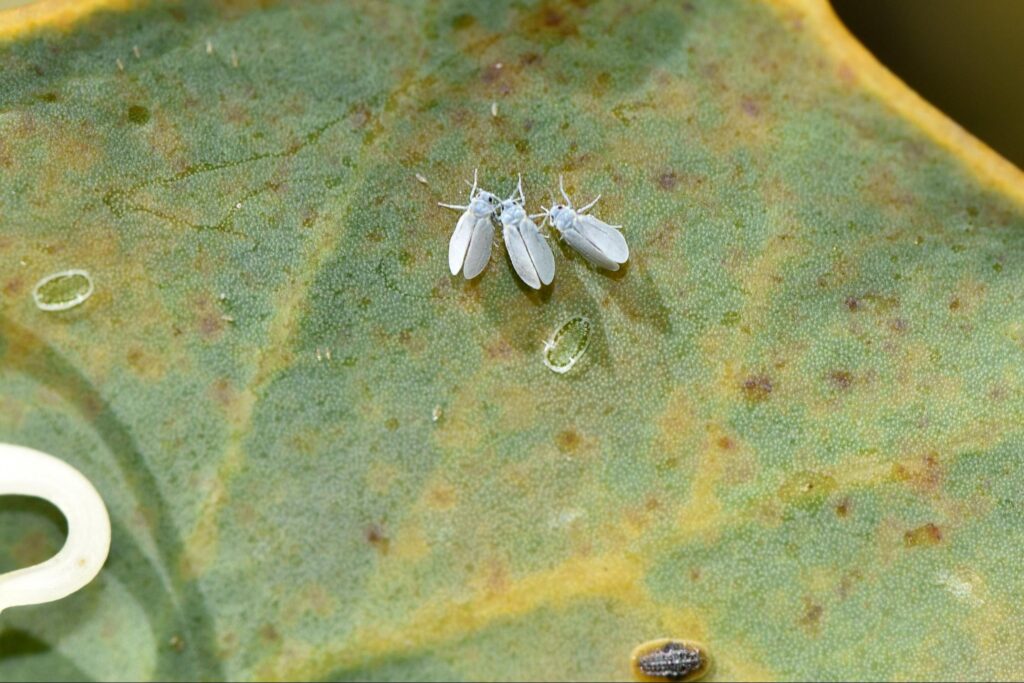
Whitefly infestation on the underside of host plant leaves Photo Credit
This guide will discuss whiteflies, their identification, and how to get rid of them by organic and inorganic means.
What Are Whiteflies?
Whiteflies are members of the insect family Aleyrodidae and the order Diptera. They are tiny, sap-sucking pests of vegetables and ornamental plants, particularly in warm weather.
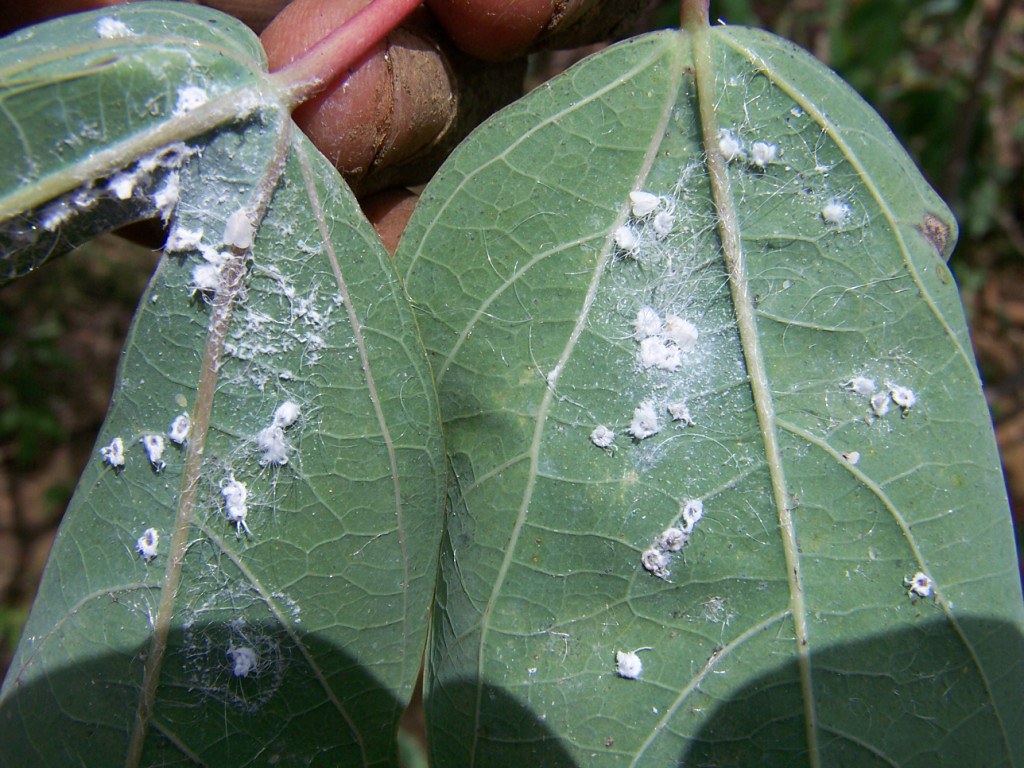
A group of whiteflies (Bemisia tabaci) feeding on the underside of host plants’ leaves Photo Credit
Whitefly infestations are more common on the underside of leaves and in large colonies. Large crowds of winged adult whiteflies fly into the air when infested plants are disturbed. They cause damage by sucking plant juices and turning the foliage yellow and distorted. When the plant leaves are distorted and withered, they cannot process food for themselves, become weak, and ultimately die.
Moreover, whiteflies secrete honeydew on infested plants and support the growth of secondary pests. The sugary and sticky substance on leaves endorses the development of black sooty mold fungus. It also provides nutrients to black ants.
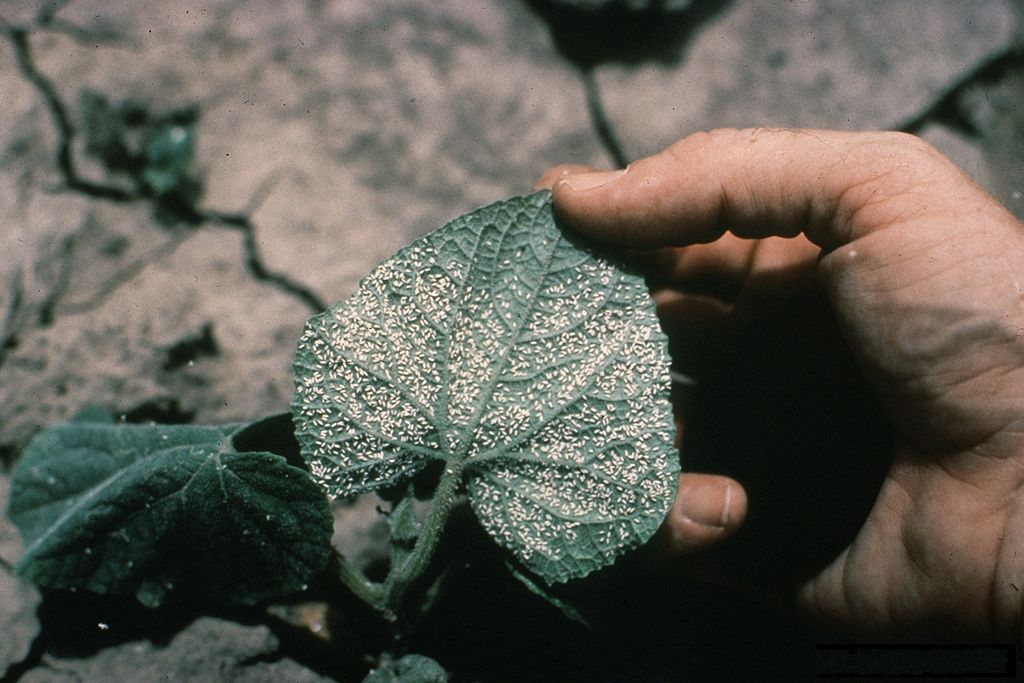
Heavily infested leaves of host plants with whiteflies Photo Credit
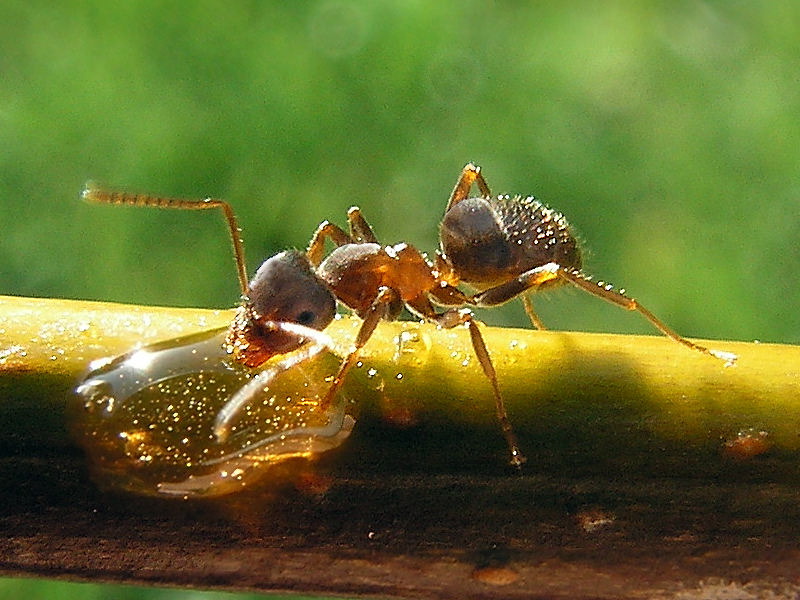
A black ant feeding on the sticky substance of whiteflies Photo Credit
Host Plants Of Whiteflies
The infestations of whiteflies remain all year round in indoor plants. However, while in outdoor gardens, these pests are more prevalent during the summer season. More than 250 host plants of whiteflies ranging from vegetables to ornamental plants. Citrus, potato, cucumber, squash, poinsettia, grape, tomato, and hibiscus are the most common host plants for whitefly infestation. The other plants as hosts for whiteflies include the weeds that provide them safe haven when no longer the food on the host plant is available.
RELATED: How To Get Rid Of Whiteflies On Houseplants For Good?
Identification Of Whitefly
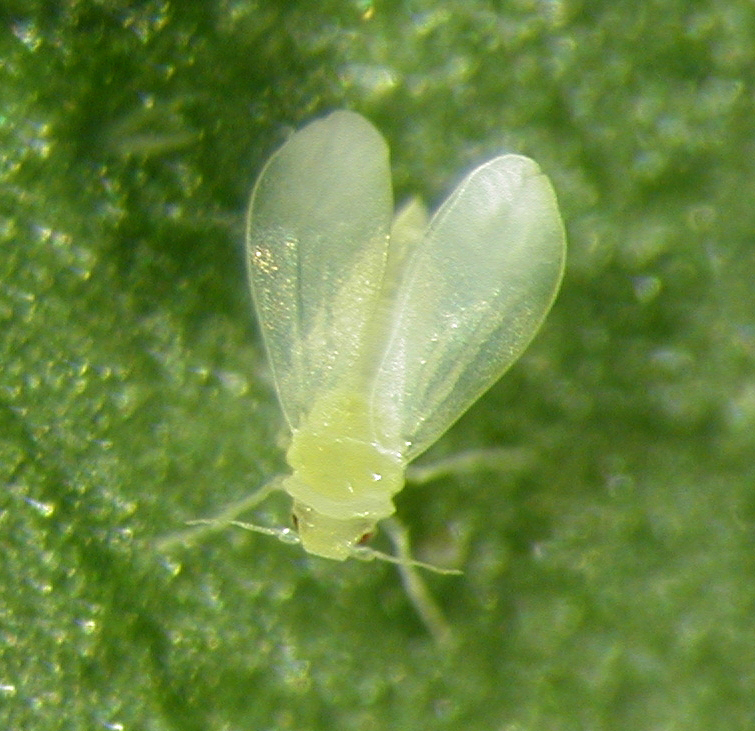
Close up of an adult whitefly Photo Credit
Adult whiteflies (merely 1/16 inch long) resemble moth flies with powdery white wings and short antennas. These tiny pests are yellowish and have four white wings, while their young are oval-shaped and are confused with scale insects.
After going through the first instar stage, the larvae attach themselves to the undersides of leaves and become sessile. These sites are termed feeding sites for larvae.
Life Cycle Of Whiteflies
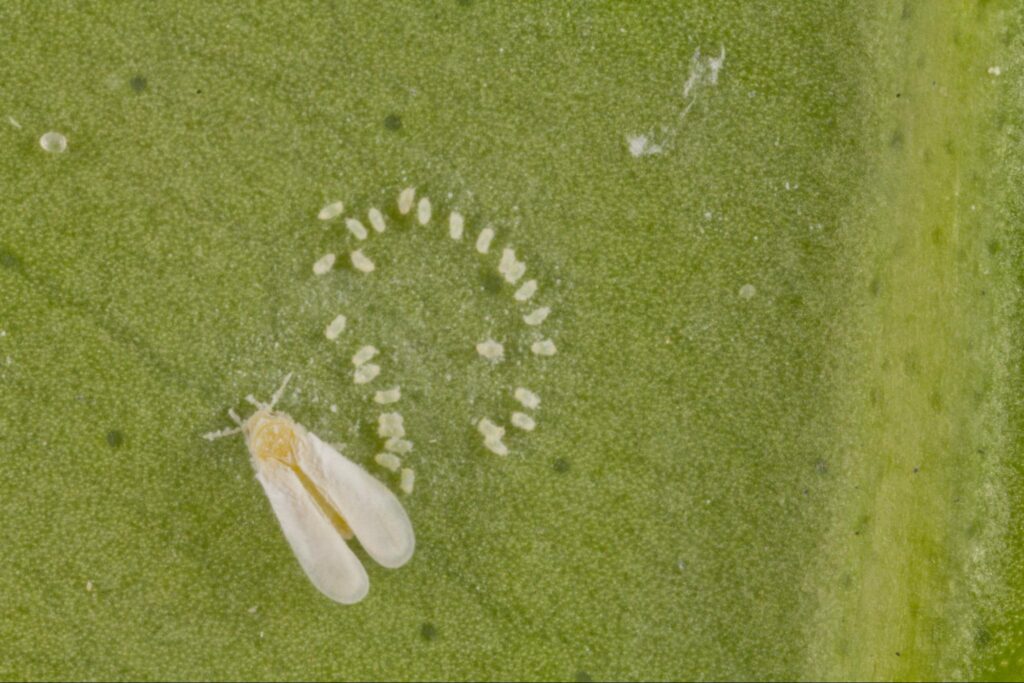
Adult whitefly along with freshly laid eggs on host plant leaf Photo Credit
In late spring, the adult whiteflies deposit their 200 to 300 eggs in clusters on the underside of leaves, near stems, and plant surfaces. The eggs hatch within 3 to 5 days, and the first instar move a short distance from the egg and flattens itself to feed on the leaf surfaces. These larvae resemble mealybugs due to their flattened and oval-shaped bodies.
The larvae undergo 3 to 5 nymphal molts during feeding before entering the sessile pupal stage. Within one week of the pupal stage, the adults appear and are ready to establish new hosts and mating.
Whitefly eggs are oblong and present on the leaves’ bottom side. These tiny white flying bugs have many generations per year with a minimum of 25 days for life cycle completion. However, if the whitefly numbers go unnoticed due to their smaller size, they become a nuisance for the outdoor and indoor plants owners.
Note: Most of the time, the immature stages of whitefly infestation go unchecked because they flatten themselves on leaf surfaces and appear similar to the leaf color (light green to yellowish). In addition to this, the larvae of whiteflies are round to oval in shape with translucent bodies. These larvae give the sense of the scale of insects on infested plants such as greenhouse whitefly infestation.
Damage Caused By Whitefly Infestation On Plants
Whiteflies are tiny white flying bugs that suck plant sap. These insect pests pierce plant tissues and suck the juice from food conducting tissues, leading yellowing of leaves.
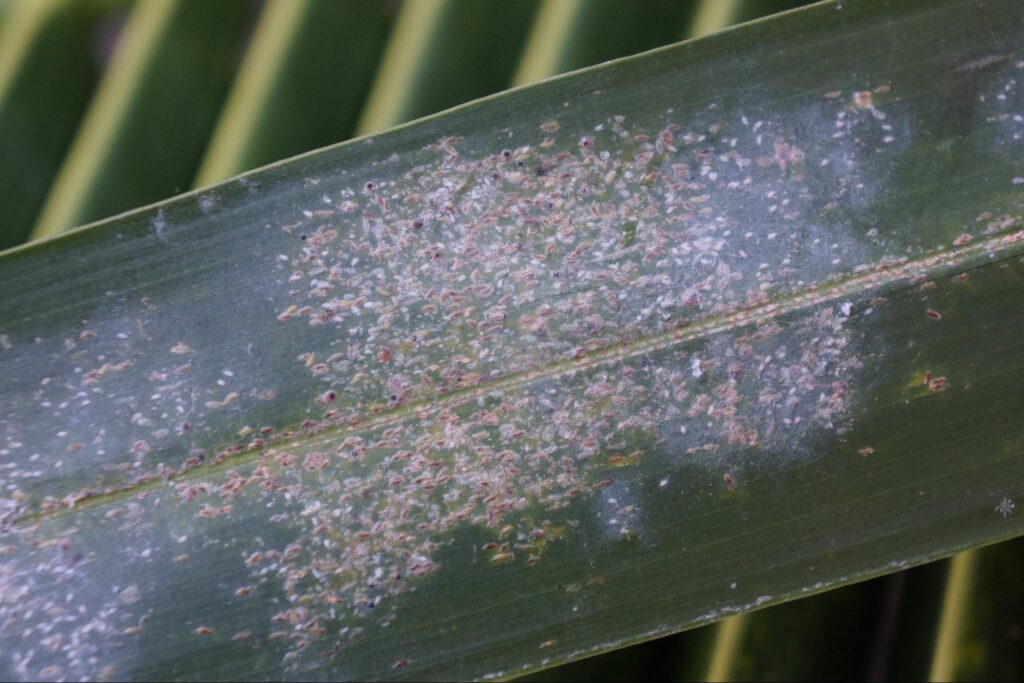
Damage caused by the whitefly infestation Photo Credit
The leaves of whitefly-infested plants appear dry and fall off plants. In the absence of leaves, the entire plant becomes weak and dies. Like all other close relatives (aphids, mealybugs, root aphids, and scale insects), the whitefly excretes sugary material on leaves. The honeydew or sugary material on leaves attracts the black sooty mold fungus that grows over leaf surfaces and interferes with photosynthesis.
On the other hand, honeydew attracts the black ants. They feed on it and interfere with the activities of natural predators. Even this secondary pest guard the whiteflies against natural enemies.
While the infested greenhouse shows the symptoms of:
- Plant discoloration
- Distortion
- Browning and yellowing of leaves with the brittle appearance
- Silvering of leaves
In vegetable crops, the whitefly damage turns the entire plant into a reservoir of plant viruses that cause severe losses such as no reproduction growth like fungal diseases.
Therefore, it is vital to get rid of whiteflies as soon as possible to protect the plants from damage.
RELATED: How to Kill Whiteflies on Houseplants? Plus Organic & Inorganic Methods
How To Get Rid Of Whiteflies?
It is essential to know both natural and chemical methods to eliminate whiteflies. In this way, you’ll be able to protect your indoor plants and garden from the tiny sap-sucking pests like whiteflies.
The following methods are easy and quick for whitefly control.
Cultural Control Of Whiteflies
The management of heavy whitefly infestations is complex. So, the best way is to prevent the introduction and development of insect pests in your garden and indoor plants. The following approaches are best to keep the whiteflies away.
- Keep your plant (indoor and outdoor) healthy because it is difficult for insects to invade and infect healthy plants. On the other hand, the susceptible plants are easy targets for whitefly attacks.
- Monitor your plant regularly for whitefly eggs and larvae. Simply pick them manually and discard them if you find any of these.
- Prune off the heavily infested leaves, branches, and twigs to prevent spreading over other healthy neighboring plants.
- Quarantine the newly purchased houseplants outdoors and regularly check them for insect infestations. After one to two weeks of monitoring, shift them inside.
- Re-pot the old but healthy plants into new pots with potting soil mix to discourage future infestation and carefully examine plant roots for root rot pathogens.
Use Yellow Sticky Traps To Get Rid Of Whiteflies
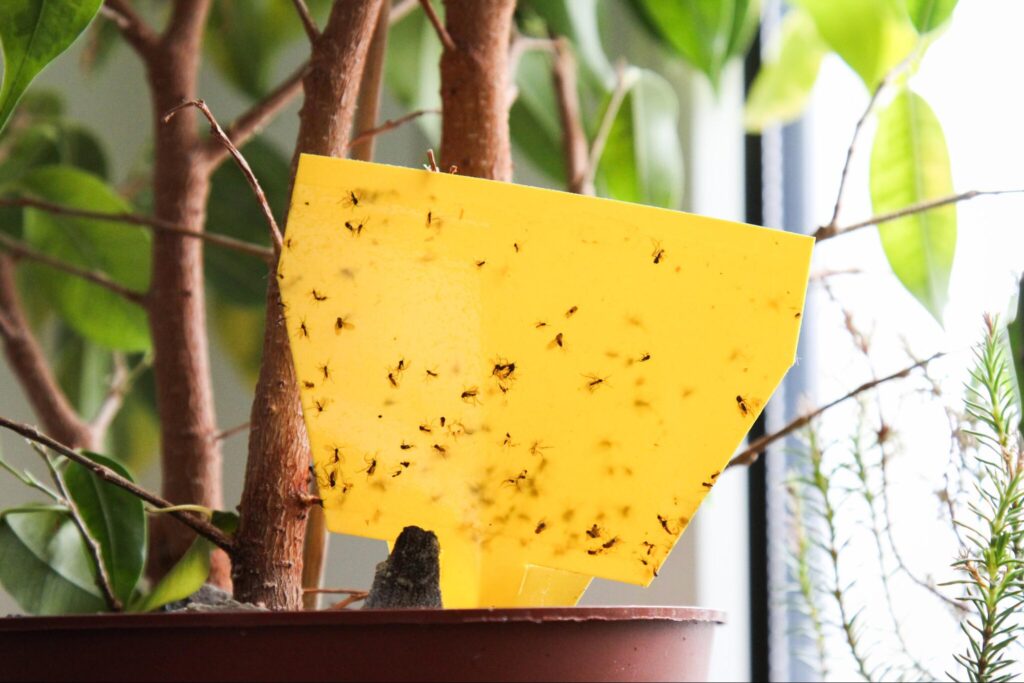
Sticky trap to capture and determine the population intensity of whitefly populations Photo Credit
The use of yellow sticky traps is a cost-effective and environmentally friendly approach to determining the population intensity of adult whitefly in gardens. Not only this, the bright color of the sticky card will attract the beneficial insects to munch on whitefly eggs and larvae.
Place or hang the yellow sticky traps near your plants to capture the nasty pests.
Even you can make your adhesive trap by using
- One part of petroleum jelly and mineral oil
- One part liquid dish soap
Mix these two materials thoroughly and spread over boards or cards to trap Silverleaf whitefly and bandedwinged whitefly.
Encourage Beneficial Insects For Whitefly Control
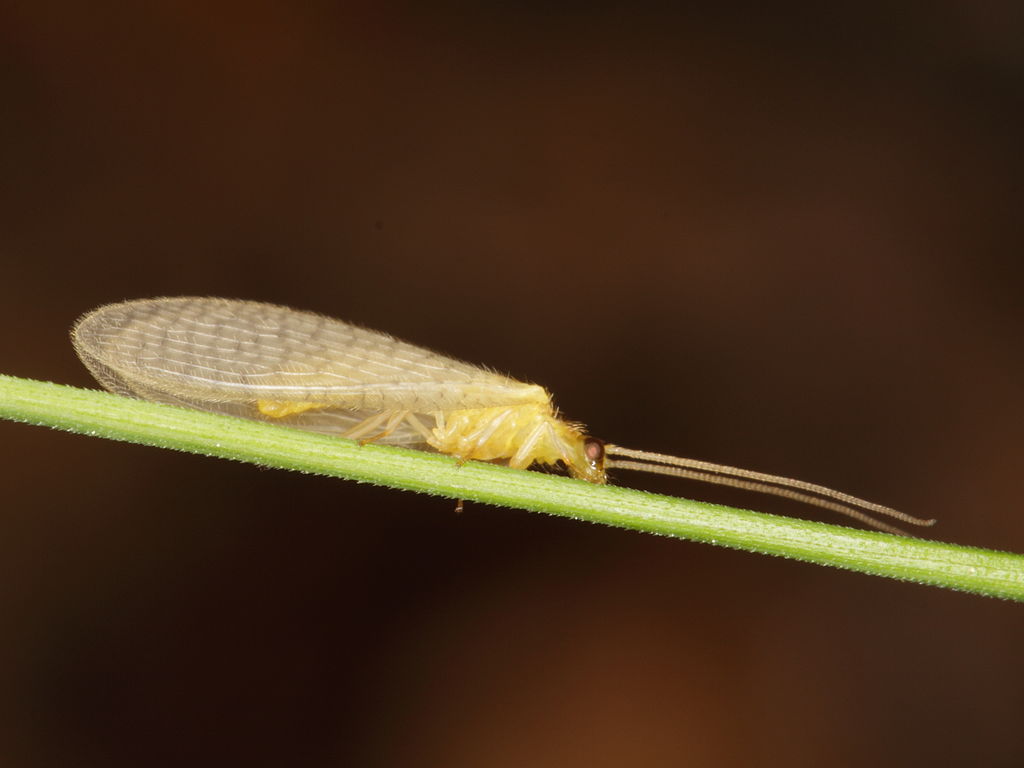
Green lacewing in the hunt for whiteflies—the most aggressive eater of whiteflies and aphids Photo Credit
The natural predators of whiteflies are also a great way to get rid of whiteflies. These enemies of whiteflies hunt down them during the growing season and help growers achieve their goals.
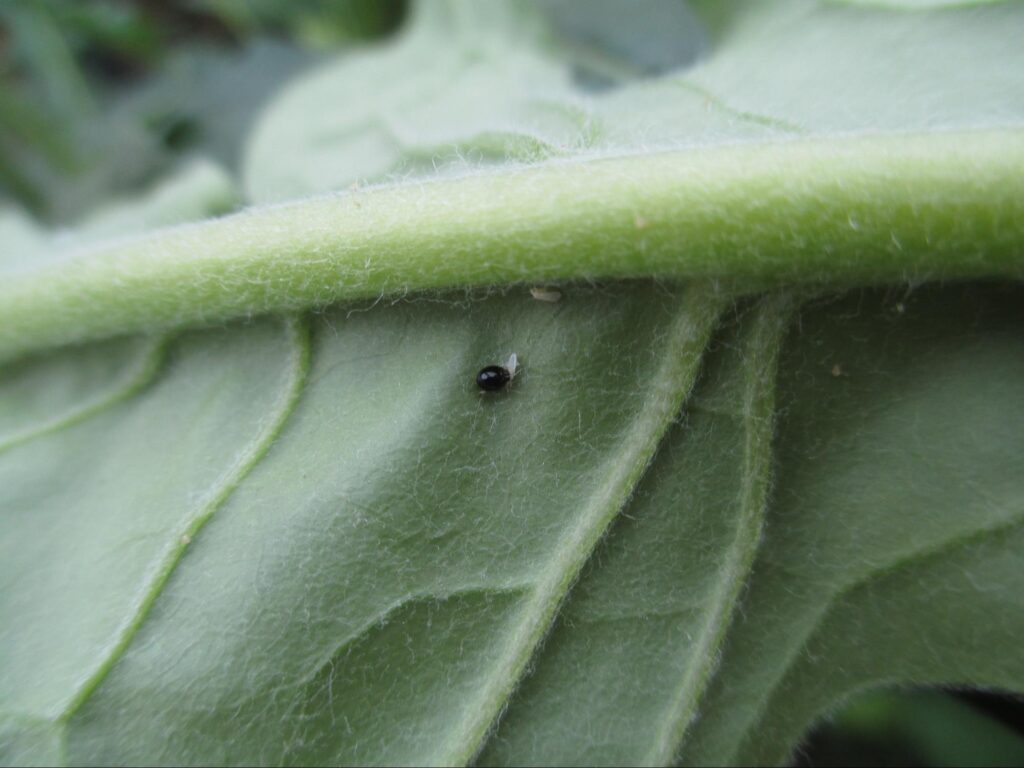
The black beetle munching on whitefly—another helpful insect to get rid of whiteflies Photo Credit
First, to establish natural enemies in your garden, provide them with their food (whiteflies). Once they are set (able to complete many generation cycles), these natural enemies of whiteflies will provide long-term protection in outdoor plants.
The natural enemies of whiteflies include green lacewings, lady beetles, and parasitic wasps. All these insects are the voracious eaters of whiteflies.
Note: Most importantly, do not apply any chemical insecticides in your garden to avoid killing whitefly predators. Such as imidacloprid and carbaryl are disruptive for natural enemies.
Use Neem Oil Spray To Kill Whiteflies
The control of whitefly larvae and adult flying insects through harsh insecticides is difficult because they can harm whitefly predators. So apply the least toxic and plant-origin spray to eliminate whiteflies, such as neem oil, vegetable oil, and insecticidal soap on infected plants.
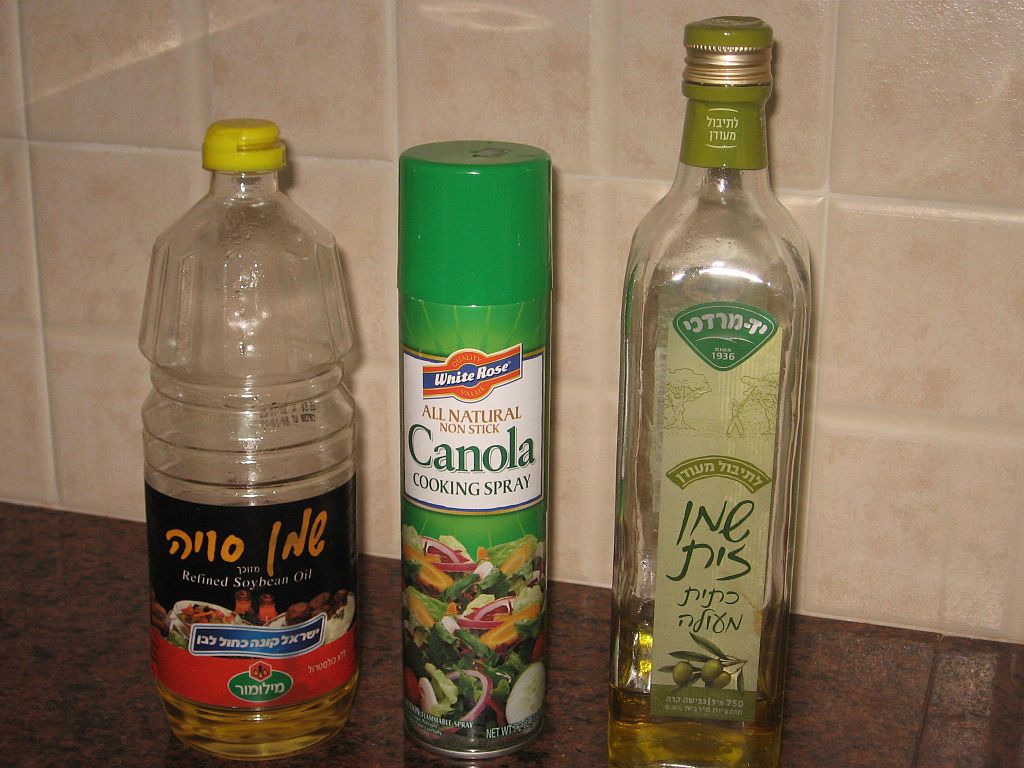
A combination of natural sprays for the control of whiteflies on outdoor and indoor plants Photo Credit
Neem oil spray is the most effective control agent for plant sap-sucking pests. It can kill the problem at all life cycle stages and is practical all year round. To prepare a neem oil spray,
- Take one tablespoon of neem oil with one tablespoon of liquid dish soap per four parts of water.
- Mix in a bowl thoroughly and pour into a spray bottle.
- Spray on infected plants to deter whiteflies such as citrus whitefly and greenhouse whitefly.
Use Insecticidal Soap Spray To Deter Whiteflies
Like neem oil, insecticidal soap sprays also eliminate whiteflies from the host and other plants. The biweekly spray of insecticidal soap will control whiteflies and prevent plants from stunted growth. These soaps work as antifeedants and damage the nervous system of insects.
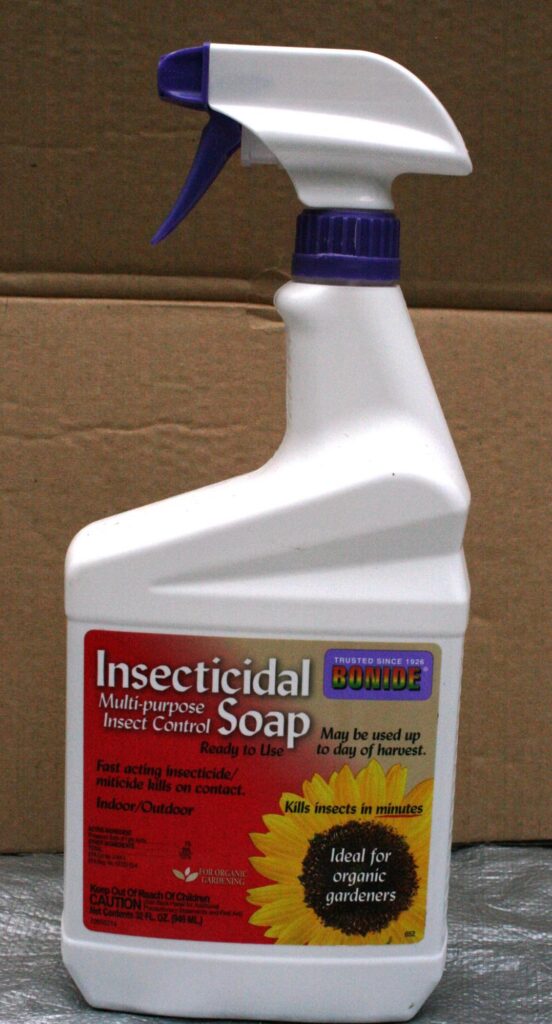
Insecticidal soap for the control of whiteflies in indoor and outdoor plants Photo Credit
Moreover, they cause dehydration and death in insects within seven-hour of application. Therefore, apply 2.5 oz of insecticidal soap/gallon of water every 7 to 10 days. Make sure to cover the leaf areas thoroughly to destroy whiteflies entirely.
Spray Liquid Soap To Kill Whitefly Adults
It is the best solution (liquid dish soap plus water) to get rid of whitefly adults in an environment-friendly way. Using this spray will not harm your plants. Take one tablespoon of the dish soap per one gallon of water and mix it well.
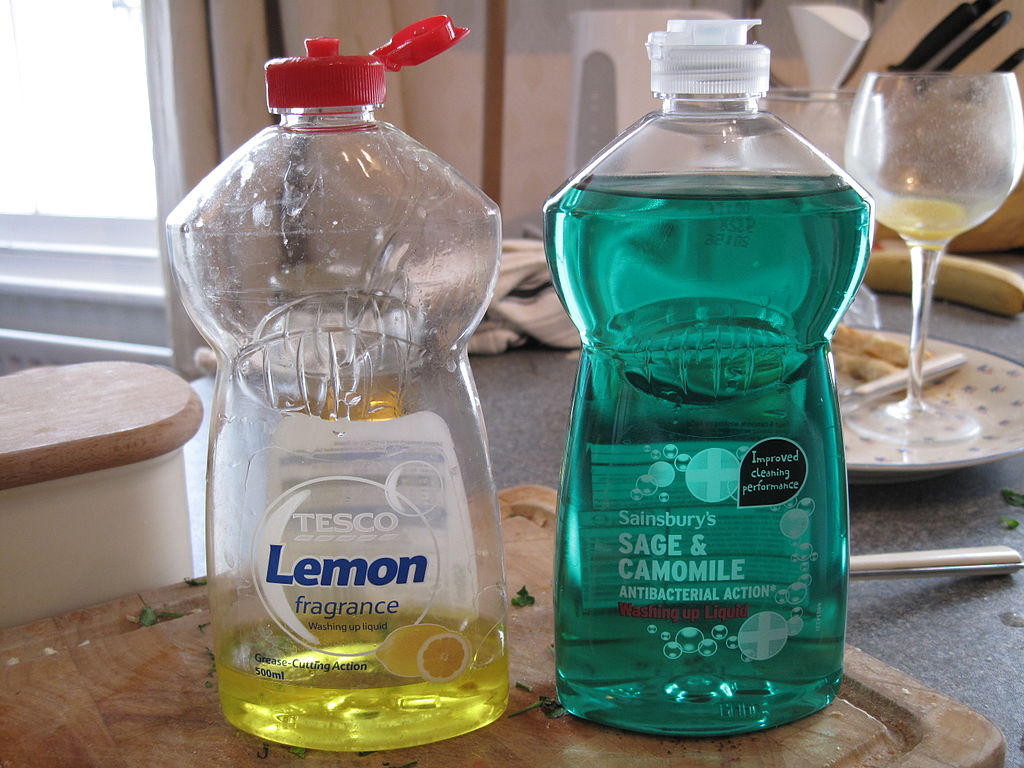
Household dish soap for the control of whiteflies Photo Credit
Pour into a spray bottle and spray on plants to kill the whitefly population on your favorite plants. Make sure to saturate the leaves to get rid of whiteflies fully.
Frequently Asked Questions (FAQs)
What is the Lifespan of Whitefly?
Under favorable weather conditions such as 70ºF, the greenhouse whitefly adults live for 30 to 40 days. The eggs hatch within 6 to 10 days, and the larval stages feed on foliage for 4 to 5 days before undergoing the pupal stage.
What is an Organic Way to Treat Whitefly Infestation?
The following practices are best to get rid of whiteflies feed
- Introduce natural predators such as green lacewings, parasitic wasps, and lady beetles.
- Use high streams of water to hose off the giant.
- Apply organic mulch and crop covers to prevent whiteflies from resting on your leaves and looking for plant sap.
- Remove infected leaves and branches to avoid further spread.
- Use adhesive traps such as petroleum jelly and mineral oil to trap the adults and interfere with their generation cycle.
- Spray your houseplants with vegetable oil to suffocate the young and adult whiteflies.
Can I Use Dawn Dish Soap on my Plants?
Yes, it is safe to use dish soap as the natural solution to repel whiteflies on your plants. It does not harm your pets and plants but kills the whiteflies by destroying their brain functions. In the case of heavy infestations, spray this solution regularly. Once the whitefly numbers are in control, follow a weekly application routine.
How Do You Revive a Dying Plant with Hydrogen Peroxide?
Hydrogen peroxide is an effective chemical in killing microbes and other pests and relieving plants from stress. So yes, you can revive a dying plant with a 3% hydrogen peroxide solution.
For this purpose, mix one part of three percent hydrogen peroxide into two parts of water. Pour this into a spray bottle and spread it over the plant. Then remove the plant from an old pot, remove the soil around the roots, and re-pot the plant into a new disease-free potting soil mix.
Can Whiteflies Live Without Plants?
Whiteflies can not live without their host plants, and they’ll die in the absence of their potential host plants. Even the suitable weather conditions will not provide them a safe haven for survival. So, it can be a possible approach to get rid of whiteflies by removing their host plants in greenhouse environments.
Do Ladybugs Eat Whiteflies?
The ladybug is a beneficial insect and munches on various plants, such as aphids, whiteflies, mealybugs, spider mites, potato beetle larvae, weevil, bean thrip, and grape rootworms. Ladybugs aggressively eat all these pests.
Ladybugs eat the garden pests at all stages of their life cycle. Even the larvae of beetles also eat out the adult whiteflies and their larvae, eggs.
Can Vinegar Get Rid of Whiteflies?
Vinegar also works as an insecticide and is effective in killing whiteflies. To prepare a practical spray.
- Mix two tablespoons of baking soda.
- Add two tablespoons of detergent and white vinegar.
- Mix all these ingredients in one gallon of water.
- Pour into a spray bottle and spray on the underside of leaves to kill tiny white bugs and prevent plant growth.
Sources For Further Reading
- Flint, M. L. (2015b, September). Whiteflies Management Guidelines–UC IPM. University of California Agriculture & Natural Resources. Retrieved April 21, 2022, from http://ipm.ucanr.edu/PMG/PESTNOTES/pn7401.html
- Agriculture and Food. (2018, May). Whitefly | Agriculture, and Food. Department of Primary Industries and Regional Development. Retrieved April 21, 2022, from https://www.agric.wa.gov.au/pest-insects/whitefly
- Silverleaf Whitefly. (2018, October 8). Field Guide to Common Texas Insects. Retrieved April 21, 2022, from https://texasinsects.tamu.edu/silverleaf-whitefly/
- Whiteflies on Greenhouse Crops. (2017, July 5). Center for Agriculture, Food, and the Environment. Retrieved April 21, 2022, from https://ag.umass.edu/greenhouse-floriculture/fact-sheets/whiteflies-on-greenhouse-crops
Now that you know how to get rid of whiteflies, make sure to check out our other articles:
How to Kill Maggots with Bleach? Know About Various Methods!
How to Prevent Gnats in Houseplants? Plus Effective Tips!
Aphids on Indoor Houseplants: 10+ Smart Ways to Get Rid of Them!







